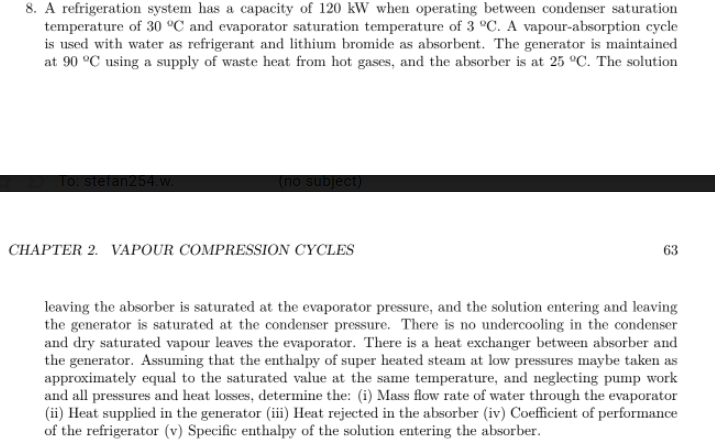8. A refrigeration system has a capacity of 120 kW when operating between condenser saturation temperature of 30 °C and evaporator saturation temperature of 3 °C. A vapour-absorption cycle is used with water as refrigerant and lithium bromide as absorbent. The generator is maintained at 90 °C using a supply of waste heat from hot gases, and the absorber is at 25 °C. The solution (no subje stefan254. CHAPTER 2. VAPOUR COMPRESSION CYCLES 63 leaving the absorber is saturated at the evaporator pressure, and the solution entering and leaving the generator is saturated at the condenser pressure. There is no undercooling in the condenser and dry saturated vapour leaves the evaporator. There is a heat exchanger between absorber and the generator. Assuming that the enthalpy of super heated steam at low pressures maybe taken as approximately equal to the saturated value at the same temperature, and neglecting pump work and all pressures and heat losses, determine the: (i) Mass flow rate of water through the evaporator (ii) Heat supplied in the generator (ii) Heat rejected in the absorber (iv) Coefficient of performance of the refrigerator (v) Specific enthalpy of the solution entering the absorber.
8. A refrigeration system has a capacity of 120 kW when operating between condenser saturation temperature of 30 °C and evaporator saturation temperature of 3 °C. A vapour-absorption cycle is used with water as refrigerant and lithium bromide as absorbent. The generator is maintained at 90 °C using a supply of waste heat from hot gases, and the absorber is at 25 °C. The solution (no subje stefan254. CHAPTER 2. VAPOUR COMPRESSION CYCLES 63 leaving the absorber is saturated at the evaporator pressure, and the solution entering and leaving the generator is saturated at the condenser pressure. There is no undercooling in the condenser and dry saturated vapour leaves the evaporator. There is a heat exchanger between absorber and the generator. Assuming that the enthalpy of super heated steam at low pressures maybe taken as approximately equal to the saturated value at the same temperature, and neglecting pump work and all pressures and heat losses, determine the: (i) Mass flow rate of water through the evaporator (ii) Heat supplied in the generator (ii) Heat rejected in the absorber (iv) Coefficient of performance of the refrigerator (v) Specific enthalpy of the solution entering the absorber.
Introduction to Chemical Engineering Thermodynamics
8th Edition
ISBN:9781259696527
Author:J.M. Smith Termodinamica en ingenieria quimica, Hendrick C Van Ness, Michael Abbott, Mark Swihart
Publisher:J.M. Smith Termodinamica en ingenieria quimica, Hendrick C Van Ness, Michael Abbott, Mark Swihart
Chapter1: Introduction
Section: Chapter Questions
Problem 1.1P
Related questions
Question

Transcribed Image Text:8. A refrigeration system has a capacity of 120 kW when operating between condenser saturation
temperature of 30 °C and evaporator saturation temperature of 3 °C. A vapour-absorption cycle
is used with water as refrigerant and lithium bromide as absorbent. The generator is maintained
at 90 °C using a supply of waste heat from hot gases, and the absorber is at 25 °C. The solution
(no subje
stefan254.
CHAPTER 2. VAPOUR COMPRESSION CYCLES
63
leaving the absorber is saturated at the evaporator pressure, and the solution entering and leaving
the generator is saturated at the condenser pressure. There is no undercooling in the condenser
and dry saturated vapour leaves the evaporator. There is a heat exchanger between absorber and
the generator. Assuming that the enthalpy of super heated steam at low pressures maybe taken as
approximately equal to the saturated value at the same temperature, and neglecting pump work
and all pressures and heat losses, determine the: (i) Mass flow rate of water through the evaporator
(ii) Heat supplied in the generator (ii) Heat rejected in the absorber (iv) Coefficient of performance
of the refrigerator (v) Specific enthalpy of the solution entering the absorber.
Expert Solution
This question has been solved!
Explore an expertly crafted, step-by-step solution for a thorough understanding of key concepts.
Step by step
Solved in 5 steps

Recommended textbooks for you

Introduction to Chemical Engineering Thermodynami…
Chemical Engineering
ISBN:
9781259696527
Author:
J.M. Smith Termodinamica en ingenieria quimica, Hendrick C Van Ness, Michael Abbott, Mark Swihart
Publisher:
McGraw-Hill Education

Elementary Principles of Chemical Processes, Bind…
Chemical Engineering
ISBN:
9781118431221
Author:
Richard M. Felder, Ronald W. Rousseau, Lisa G. Bullard
Publisher:
WILEY

Elements of Chemical Reaction Engineering (5th Ed…
Chemical Engineering
ISBN:
9780133887518
Author:
H. Scott Fogler
Publisher:
Prentice Hall

Introduction to Chemical Engineering Thermodynami…
Chemical Engineering
ISBN:
9781259696527
Author:
J.M. Smith Termodinamica en ingenieria quimica, Hendrick C Van Ness, Michael Abbott, Mark Swihart
Publisher:
McGraw-Hill Education

Elementary Principles of Chemical Processes, Bind…
Chemical Engineering
ISBN:
9781118431221
Author:
Richard M. Felder, Ronald W. Rousseau, Lisa G. Bullard
Publisher:
WILEY

Elements of Chemical Reaction Engineering (5th Ed…
Chemical Engineering
ISBN:
9780133887518
Author:
H. Scott Fogler
Publisher:
Prentice Hall


Industrial Plastics: Theory and Applications
Chemical Engineering
ISBN:
9781285061238
Author:
Lokensgard, Erik
Publisher:
Delmar Cengage Learning

Unit Operations of Chemical Engineering
Chemical Engineering
ISBN:
9780072848236
Author:
Warren McCabe, Julian C. Smith, Peter Harriott
Publisher:
McGraw-Hill Companies, The